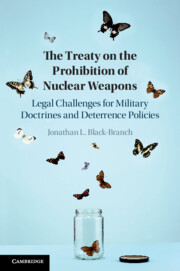 The Treaty on the Prohibition of Nuclear Weapons
The Treaty on the Prohibition of Nuclear Weapons Book contents
- The Treaty on the Prohibition of Nuclear Weapons
- Reviews
- The Treaty on the Prohibition of Nuclear Weapons
- Copyright page
- Contents
- Foreword
- Preface
- Acknowledgments
- Abbreviations
- 1 Changing the Status Quo in Nuclear Arms Control Law: The Treaty on the Prohibition of Nuclear Weapons 2017
- 2 Adopting the Treaty on the Prohibition of Nuclear Weapons 2017: A New Dawn, a New Deal, a New Direction in Nuclear Disarmament Law?
- 3 Humanitarian Nuclear Disarmament: Challenging the Status Quo through New Approaches to Legal Process, Purpose and Provisions
- 4 Legal Congruence with Existing Treaty Obligations: Toward Complementary or Competing Interests?
- 5 Customary International Law, Opinio Juris and State Practice Regarding the Treaty on the Prohibition of Nuclear Weapons 2017: Toward Universality?
- 6 Treaty Safeguards, Verification and Implementation: A Simple-Ban Approach and a Need for Oversight
- 7 Nuclear Deterrence Policies and the Prohibition Treaty: Disarmament Considerations
- 8 Nuclear Defense Doctrines: Disarmament and Emerging Humanitarian Concerns
- 9 Competition, Fragmentation and Polarization: A Bifurcated International Legal Infrastructure Regarding the Nuclear Architecture and Regulation?
- 10 Stigmatization-Action and Changing Global Perceptions to Delegitimize and Eliminate Nuclear Weapons
- 11 Toward Neo-Universalism: Toward a New Reality in International Law?
- 12 Obligations Erga Omnes: The Missing Link for Nuclear Nonproliferation and Disarmament Compliance
- 13 The Treaty on the Prohibition of Nuclear Weapons within the Nuclear Nonproliferation and Security Architecture in International Law: From Grand Bargain to Grand Challenges with the Right to Nuclear Peace and Freedom from Nuclear Fear: Summaries and Conclusions
- Index
1 - Changing the Status Quo in Nuclear Arms Control Law: The Treaty on the Prohibition of Nuclear Weapons 2017
Published online by Cambridge University Press: 17 April 2021
- The Treaty on the Prohibition of Nuclear Weapons
- Reviews
- The Treaty on the Prohibition of Nuclear Weapons
- Copyright page
- Contents
- Foreword
- Preface
- Acknowledgments
- Abbreviations
- 1 Changing the Status Quo in Nuclear Arms Control Law: The Treaty on the Prohibition of Nuclear Weapons 2017
- 2 Adopting the Treaty on the Prohibition of Nuclear Weapons 2017: A New Dawn, a New Deal, a New Direction in Nuclear Disarmament Law?
- 3 Humanitarian Nuclear Disarmament: Challenging the Status Quo through New Approaches to Legal Process, Purpose and Provisions
- 4 Legal Congruence with Existing Treaty Obligations: Toward Complementary or Competing Interests?
- 5 Customary International Law, Opinio Juris and State Practice Regarding the Treaty on the Prohibition of Nuclear Weapons 2017: Toward Universality?
- 6 Treaty Safeguards, Verification and Implementation: A Simple-Ban Approach and a Need for Oversight
- 7 Nuclear Deterrence Policies and the Prohibition Treaty: Disarmament Considerations
- 8 Nuclear Defense Doctrines: Disarmament and Emerging Humanitarian Concerns
- 9 Competition, Fragmentation and Polarization: A Bifurcated International Legal Infrastructure Regarding the Nuclear Architecture and Regulation?
- 10 Stigmatization-Action and Changing Global Perceptions to Delegitimize and Eliminate Nuclear Weapons
- 11 Toward Neo-Universalism: Toward a New Reality in International Law?
- 12 Obligations Erga Omnes: The Missing Link for Nuclear Nonproliferation and Disarmament Compliance
- 13 The Treaty on the Prohibition of Nuclear Weapons within the Nuclear Nonproliferation and Security Architecture in International Law: From Grand Bargain to Grand Challenges with the Right to Nuclear Peace and Freedom from Nuclear Fear: Summaries and Conclusions
- Index
Summary
The Treaty on the Prohibition of Nuclear Weapons 2017 marks an important development in nuclear arms control law, diplomacy and relations between states. Adopted by the UN General Assembly on July 7, 2017, it was supported by 122 nations, representing a potential disruptor to the nuclear status quo. It is the first treaty to ban nuclear weapons outright, taking a clear humanitarian approach to disarmament. Despite its success in coming to fruition, however, it is not celebrated by all nations. The permanent members of the UN Security Council neither participated in its negotiations, nor adopted the final text. No state with nuclear weapons endorses the Treaty and indeed they openly oppose its very existence.
Keywords
- Type
- Chapter
- Information
- The Treaty on the Prohibition of Nuclear WeaponsLegal Challenges for Military Doctrines and Deterrence Policies, pp. 1 - 10Publisher: Cambridge University PressPrint publication year: 2021


